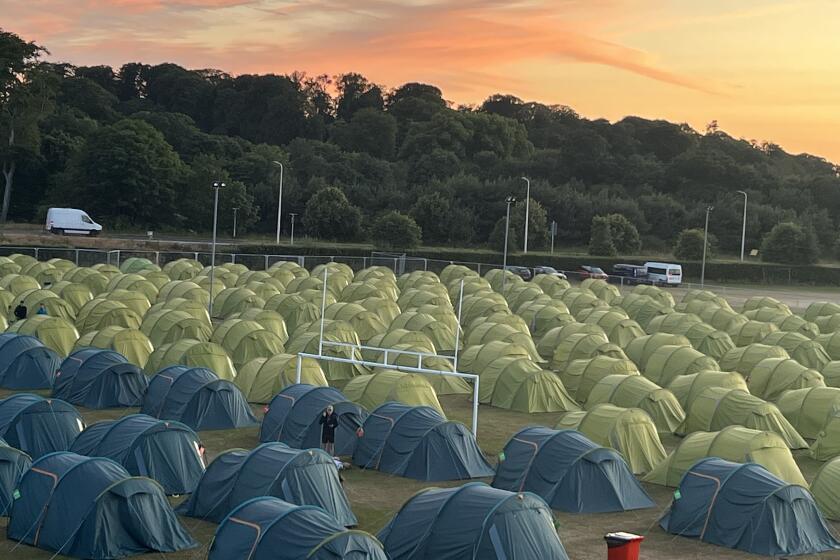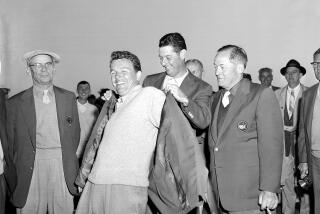What’s so great about the Old Course? Mike Tirico has 18 thoughts on the matter
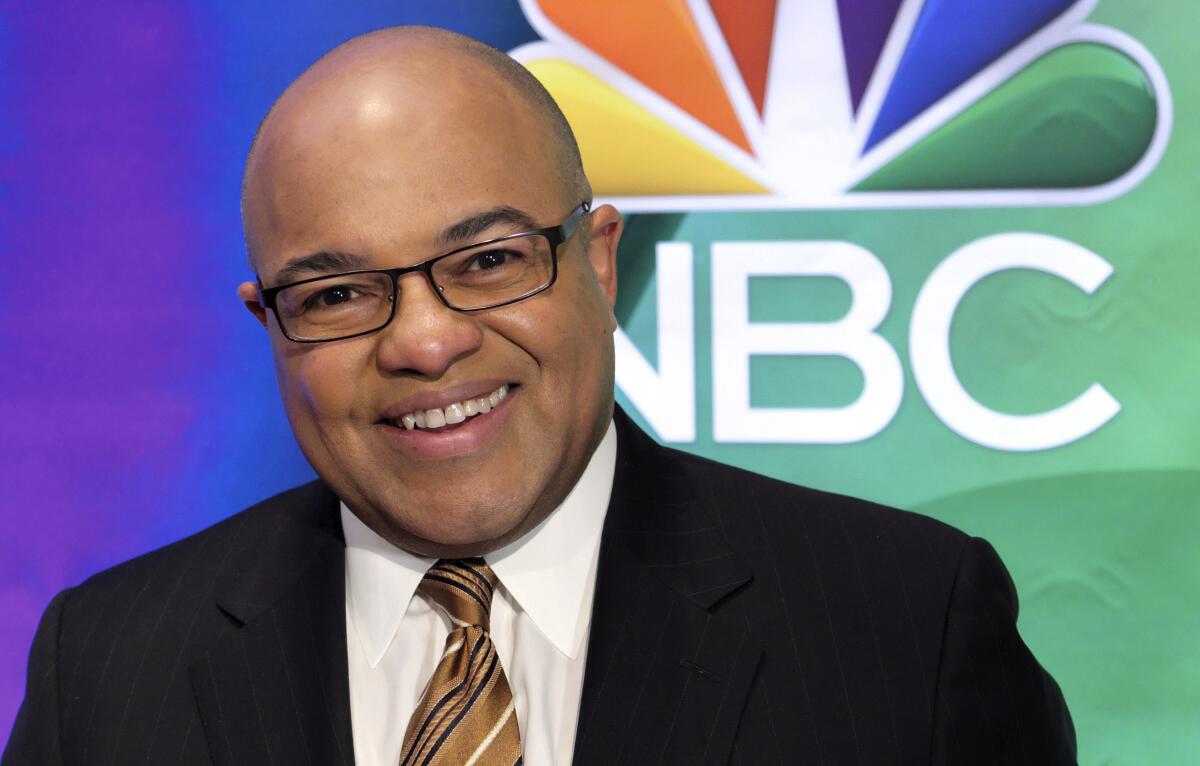
- Share via
ST ANDREWS, Scotland — The Old Course never gets old for Mike Tirico.
In 25 years covering the Open Championship, the NBC golf commentator has seen his appreciation only grow for this place.
“The whole ‘home of golf’ thing, if you don’t play, it might seem a little silly and Pollyanna,” he said. “But if you play and the game is in your soul, I think you do feel it.”
This marks the fifth Open that Tirico has covered at the Old Course, the first four when he was at ABC/ESPN.
Here, in his words, are 18 great characteristics of these 18 holes:
Don’t fence me in
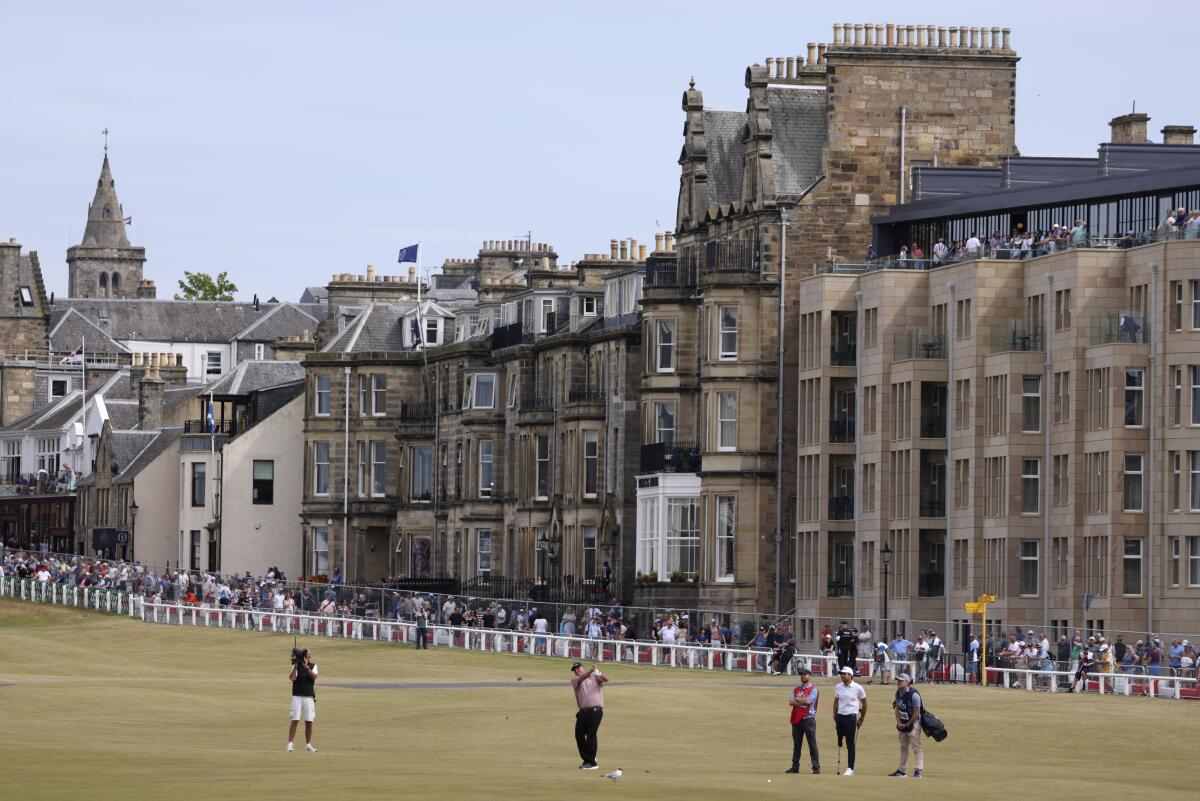
There are no jitters like the first hole in golf. You’re playing with new friends, playing in front of people. That’s magnified by the historic setting here, where the rules of golf have emanated from that building for years, the R&A, and are disseminated around the world.
The good news is, the first hole of the Old Course is the widest fairway on planet Earth. It’s 100-plus yards across, so you can almost do anything and be fine. But even Thursday, Ian Poulter almost hit it out of bounds to the left. This place even gets the best of players to feel emotional and feel a little bit of the nerves over an easy shot.
Feel the burn
There’s such a cool language here. Links — that in many ways links the sea to the town. The penalty area that cuts across the first hole is called the Swilcan Burn. It’s two yards wide and filled with water. It takes two steps to cover it.
Here’s Tiger Woods on Thursday, who probably played in his last Open here, and all the emotion, after missing the cut Friday. He hits out of a divot on the first. If anybody is going to hit it far behind the hole location, deep in the green, it’s Tiger. And he puts it in this two-yard-wide water hazard, and that begins the downfall of a day that he has been working [toward] for months. It just plays with your mind.
Boom with a view

The 12th tee is one of the cool places to be as a golfer. First off, it’s the view. You’ve finished the loop and you’re starting your trek back into town. If you’re not here during the Open and you have an Old Course caddie, a St Andrews caddie, they’re pointing to, “You see that steeple? You see that stack over there?” as your aiming points for these blind tee shots. They just don’t have that anywhere else.
When you’re playing golf at home, you’re headed back toward a nice clubhouse; you’re headed toward something that feels as if it’s there because of golf. Here, you feel as if it’s there because this is the town where golf started.
O marks the spot
The 17th is known as the Road Hole. Abraham Ancer was out here playing a practice round Sunday, and I met up with them around No. 15. Neither he nor his caddie had ever played the Road Hole before, so hitting a blind drive over the corner of a hotel was new to them. As we’re up there they said, “Where do we aim here?” I told them historically guys aim over the “O” in “Course” in Old Course Hotel and that if you hit a little draw over that, you’re going to end up in the fairway. So they looked at the book, did that and ended up in the fairway.
Abe asked me if I was going to caddie for him the rest of the week. I said, “Everybody knows that who’s been here before.” But when you’re playing back home, “Aim for the tree,” or, “Aim for the bunker,” are common instructions from a caddie. It’s never, “Aim for a letter on that railway shed.” But that’s what you do here.
A big step down
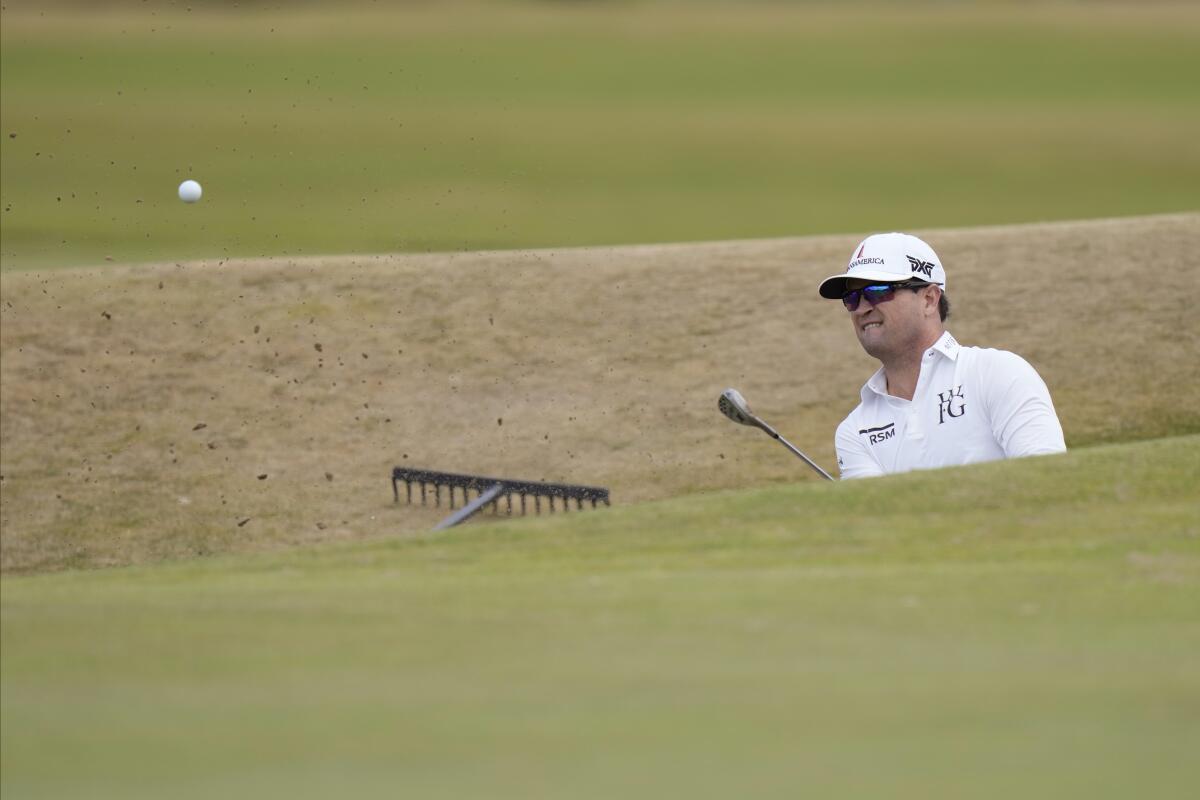
The bunkers here have “revetted” faces, which means the hard walls are layers of sod stacked on each other. They also tend to be really deep. The most famous bunker on the course is the Road Hole bunker and it’s a Jacuzzi. I walked into it on Sunday to take a picture, and it’s over my head.
On the PGA Tour, if a guy hits it into a bunker, sometimes the bunker is easier to get out of than the rough. Here, bunkers truly have a half-stroke penalty most of the time, if not a full-stroke penalty. You can be pinned up against a wall and you have to hit a ball quickly out of the sand, above your height, to get it out of there. It’s so difficult that it makes the best players, the .001 percent, look incredibly average.
Four pristine rounds
In winning the Open in 2000, Tiger famously didn’t put it in the bunker once. The Old Course had 112 bunkers at that point — it has 110 now — so he went 448 for 448. It’s really hard on this golf course to avoid all of them.
Tiger’s 15th club was the reason he dominated the field: his brain. He thinks his way around a golf course probably as well as any player ever. That’s part of why he has been so great. He has this incredible athletic ability, but he also has this great knowledge of course management and the game.
The most expensive and most affordable British Open lodgings sit side by side near St. Andrews Golf Course. A look inside the Open’s unique tent city.
Rub of the green
The difficulty here is you can hit a good shot and still get in the bunker. You need luck. Because the ball rolls out 20, 25 yards after it lands, you can hit a hump or a mound and the ball will dive toward a bunker. The bunkers feel as if they have magnetic fields around them, and your ball will take this slow, agonizing trail in.
The trolling stones
It didn’t hurt him Thursday, but Rory McIlroy hit a drive that struck a stone that’s covered in green Astroturf essentially — like Astrodome-bad Astroturf — that they use to soften the blow. There are marking stones in the fairway that go back to the 1800s when they were laying out the course and the property. They don’t go back and take out those stones, which I love. When you play here, the history is around you all the time.
Air-traffic control
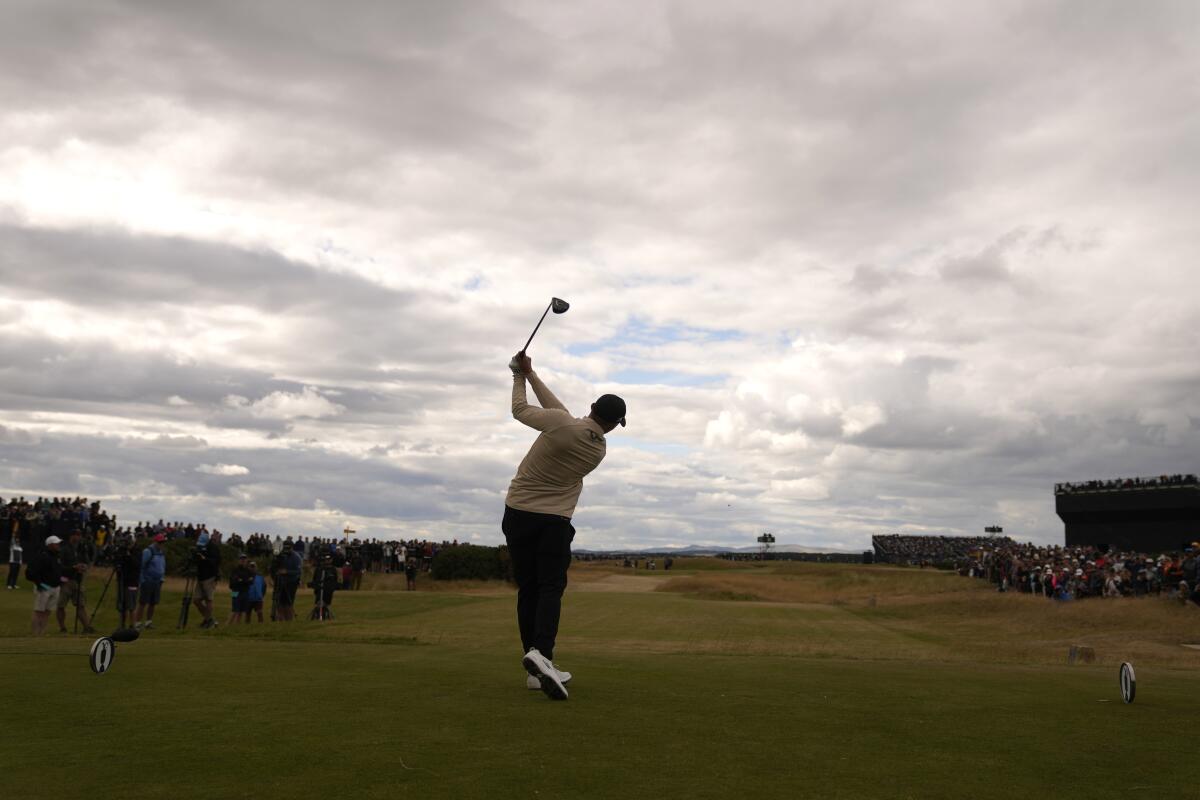
When you play your tee shot at 7, you’ll often see players stop after they walk 100 yards because to their right, the tee shots from the 11th hole are coming over their heads. That’s a really unique part of the course. Especially when there are amateurs out there, you need a hardhat. You’ve got golf balls going everywhere in that crisscross area. You can’t hide. You can see everyone.
Living on the edge
There are no trees or separations between the holes as they run parallel in the middle of the course, so the fans have to line the perimeters. You don’t get permanent cameras on the inside of the golf course. So even from a TV standpoint, you’re seeing it from the outsides. Only those handheld cameras can get you a view from the inside. You’d love to get the left side of the holes going out, and the left side coming in. But there isn’t a tree line or gorse bushes or anything else.
Tiger Woods missed the cut Friday at the 150th Open Championship in St Andrews, Scotland. He indicated he’s probably done playing for the year.
To the left, to the left
Caddies will tell you to hit it left. Because you can miss a lot to the left and not lose a ball or get in trouble. You will have a long shot, and you’ll have a different angle. If you lose it left on 3, you’ll be in the 14th fairway. It opens up in a bunch of places like that.
A numbers game
This place is the reason a round of golf is 18 holes. It was originally 22 holes here, but they felt there were a couple of holes that were too short, so they combined them to make a longer one. When they did that, the number of holes went down to 18 and that became the standard.
Newlyweds Alex Wrigley and Johanna Gustavsson are savoring their chance to be together at the British Open, with Gustavsson serving as Wrigley’s caddie.
Double trouble
Double greens — two holes on one green — were part of the original design that was the brainchild of Old Tom Morris. So when you’re playing, you could be looking at two flags: yellow for the first nine holes, red for the last nine. Four greens sit by themselves — 1, 9, 17 and 18 — and seven double greens make up the other 14. The easiest way to remember which holes share a green is they add up to 18, so 2 and 16 share, 5 and 13 share, and so on.
Pebble Beach is known for having the smallest square-footage greens in golf. The greens at the Old Course are the biggest, about six times as large as the average greens at Pebble.
Weather or not
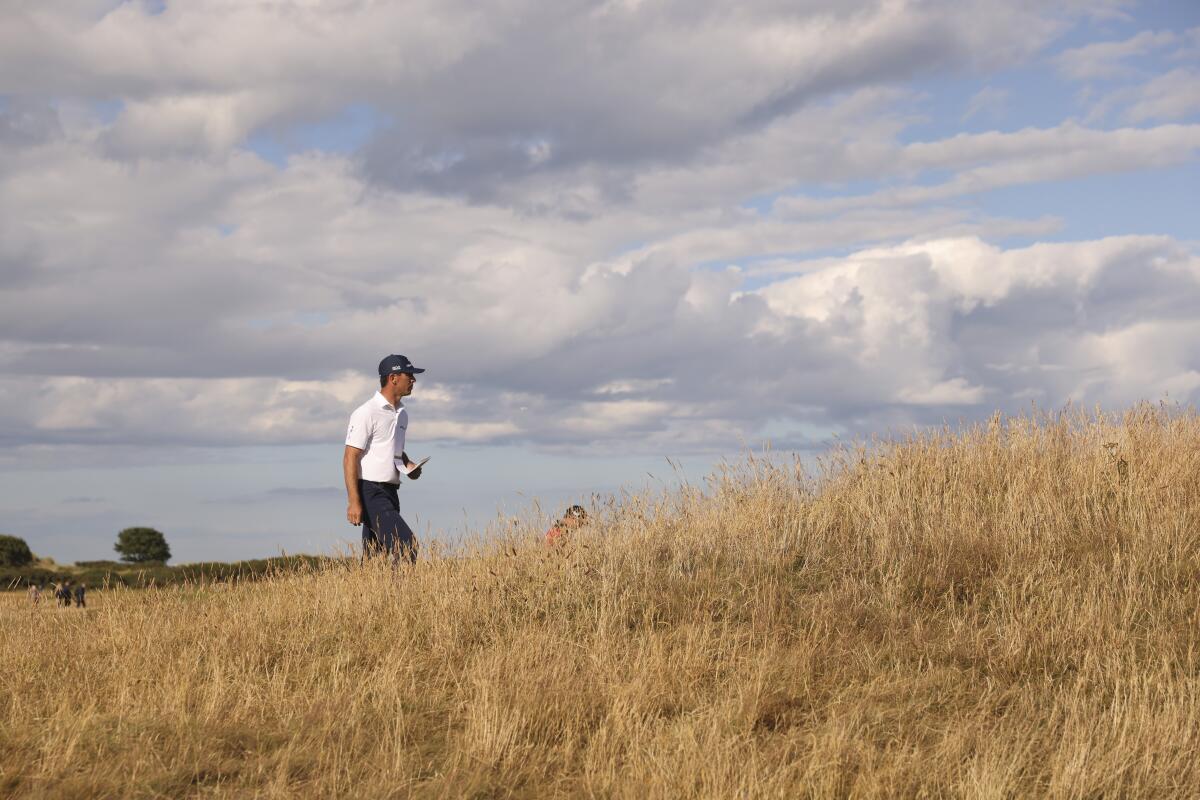
I can’t think of any other place where you’re playing where you want it to be wet and windy. But if you come over here to play, you want at least some of your experience to be really crappy weather. It just adds to your story years later. Last time we were here, it got too windy to play the Open, which is odd because wind is such a critical element. There’s nothing to stop the wind. It’s coming off the sea, and because of where these links courses are there’s no barrier. So it comes straight in and just impacts you.
So here, sometimes the wind works for you. You can get the wind at your back down wind for the early holes. And when the tide goes out, the wind usually shifts a little bit and you might get the wind at your back for the last holes as well. But for the most part the wind is helping you early and then you’re fighting it on the way back in — or vice versa. Because of the nature of the golf course, you often have the wind as your friend and then your foe within an hour.
The years that we’ve been here, the weather always impacts players in different ways at different times. Where you feel like if you walk away, “Man, if I would have gotten a better break with the weather, I would have had a better chance.”
Two-time British Open champion Greg Norman is not allowed to participate at St. Andrews because he is chief executive of the LIV Golf International series.
Luck of the draw
You could have a great start to the day and play early and have great conditions, and then get crushed depending on when your starting time is. This year, late-early — the guys who went late Thursday and early Friday — are getting the worst of the weather. Late [Thursday] it was the windiest it was, Friday morning we had rain that cleared up by the afternoon.
Steps of the greats
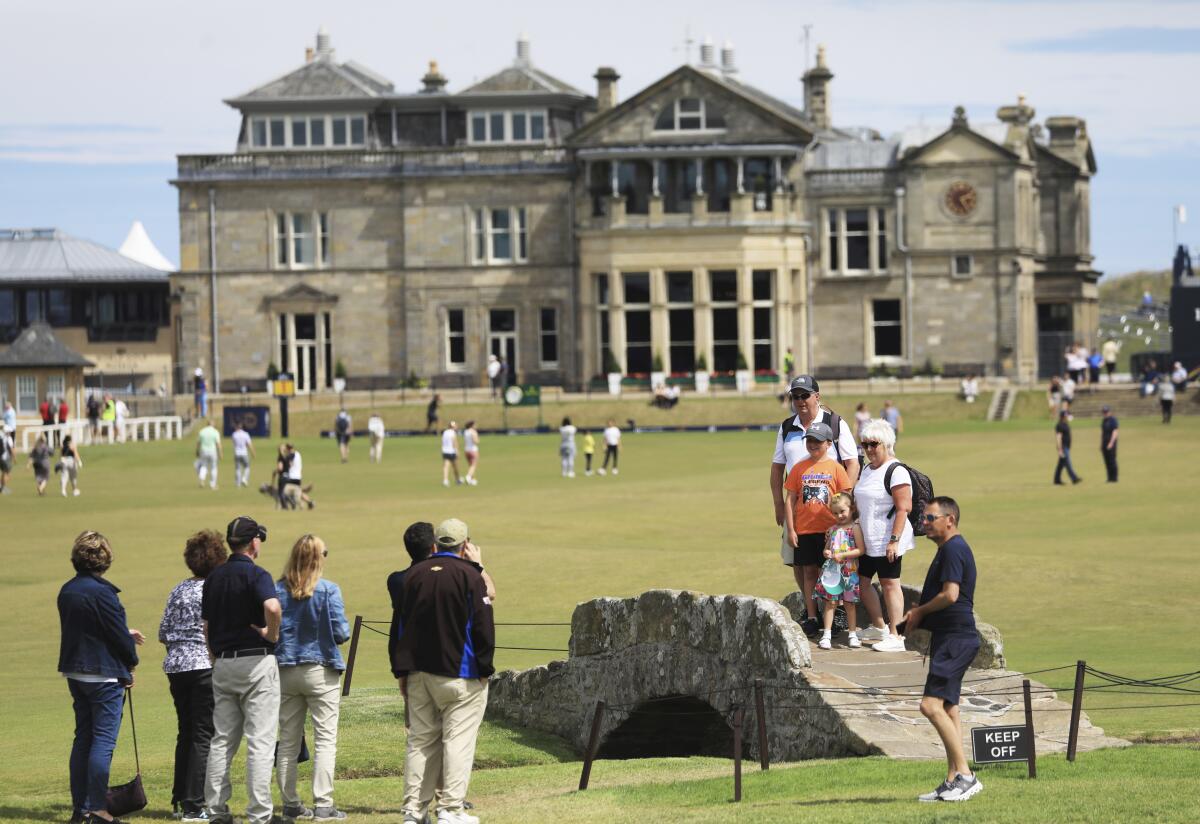
When you walk over the Swilcan Bridge on 18, you know that you’re probably crossing the same place that every great golfer has crossed. It’s not as though you’re looking at Brett Favre never played in this AFC city — even though he did and lasted forever. Every great golfer who has played St Andrews in the post-war era has walked across that bridge. It’s not as if it has been replaced and modernized.
It’s an awesome old stone bridge that has been here longer than we have, and will be here longer than we’re here. It has some slick points. Everybody takes caution and care walking over it — but they also take pictures too.
The scene at 18
Every 18th hole at the Open is cool, because the way they build the grandstands it’s like playing on a football field. If you think of somebody winning the Open, you think of them holding the Claret Jug and looking around at all sides. Here it’s like a you’re walking into the Coliseum, a crucible. The clubhouse is in the back, and you’ve got a grandstand next to that. You’ve got the fans on either side of you. You don’t get that in golf, that real football feel like you’re at the 50-yard line of a stadium. Here you do.
Back to the birthplace
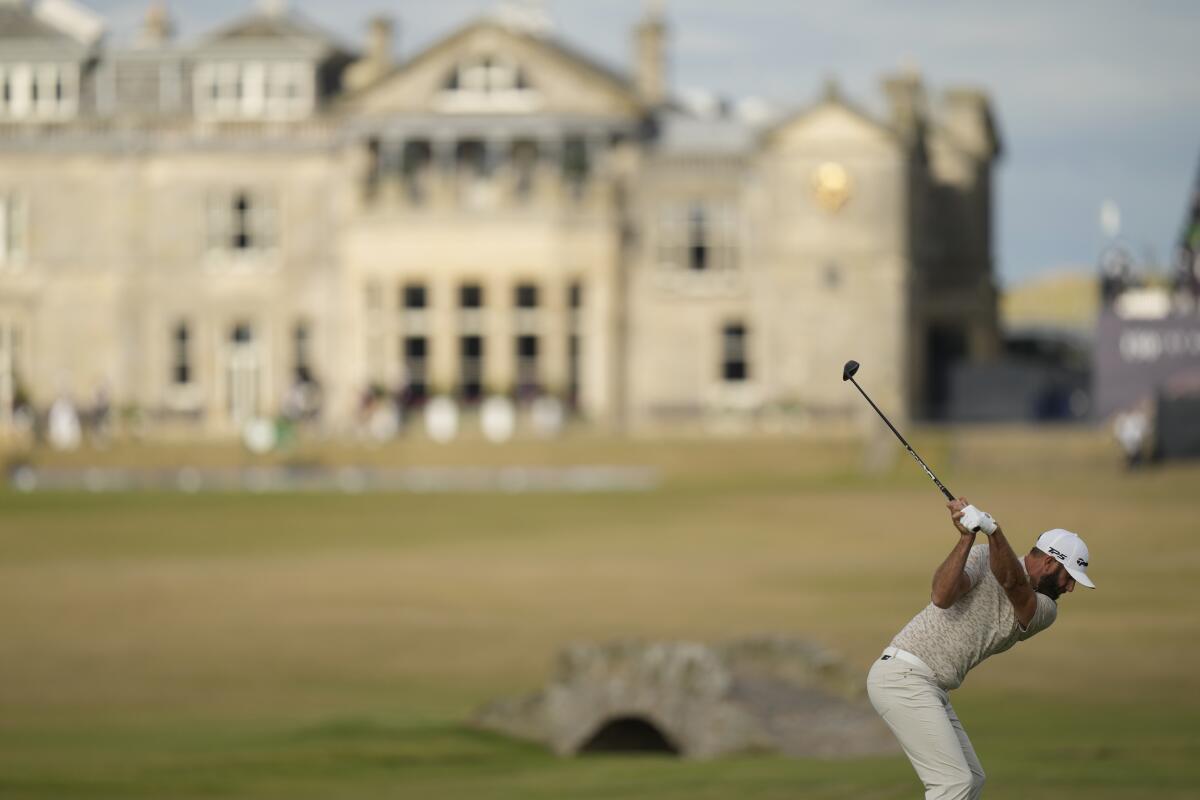
We don’t go to Cooperstown and play a World Series game. We don’t go to Springfield and play Game 3 of the NBA Finals. But we come here and play one of the most important golf events. That’s why this endures for me more than other places where a game started.
More to Read
Go beyond the scoreboard
Get the latest on L.A.'s teams in the daily Sports Report newsletter.
You may occasionally receive promotional content from the Los Angeles Times.

